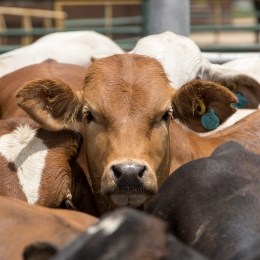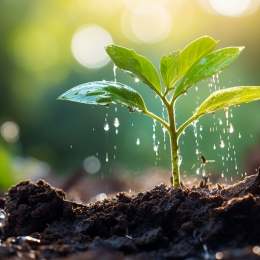Is that food really "carbon neutral"?
The world has to cut carbon dioxide emissions in half by 2030 to avoid the worst effects of climate change, says the Intergovernmental Panel on Climate Change. And by 2050, we need to hit “net zero”—that is, emissions must be matched by removals from the atmosphere.
Sounds like a marketing opportunity if we ever heard one! Are companies’ claims that they’re slashing their food’s carbon footprint legit?
Reducing emissions
“To get to net zero, we collectively have to cut our emissions as close to zero as possible,” says Freya Chay, program manager at CarbonPlan, a nonprofit that evaluates climate programs.
Food companies can cut their emissions in any number of ways:
- Energy: They could find more energy-efficient methods to make their foods, opt for renewable energy to power their operations, or use electric vehicles to transport their goods.
- Ingredients: They could buy ingredients from farms that reduce emissions or grow crops that soak up carbon like a sponge. They could cut food waste.
- Packaging: They could move away from plastic made from crude oil or natural gas or use only recycled materials in their packaging.
But many companies take an easier route to balance their carbon books: They buy carbon offsets.
Carbon offsets 101

Carbon offset credits are used to fund projects that either:
Prevent carbon emissions by, say, investing in solar or wind farms or electric transportation, or by paying landowners not to cut down trees, or
Remove carbon from the atmosphere by, for example, planting trees, investing in farming practices that store carbon, or capturing carbon from the air and pumping it underground (though this technology doesn’t currently exist at a scale large enough to have much impact).
Each credit a company buys equals one metric ton of “carbon dioxide equivalents” either not emitted or removed from the atmosphere. (The CO2 equivalents adjust for the potency of each greenhouse gas.)
In order to keep temperatures from soaring, we need to both lower emissions and remove carbon. Why?
“CO2 has an incredibly long lifetime in the atmosphere,” says Chay. “Every metric ton of CO2 we emit contributes to warming for thousands of years. To counteract any remaining emissions, we have to remove CO2 from the atmosphere and store it.”
The National Academies of Sciences, Engineering, and Medicine estimates that we need to remove an additional 10 billion tons of carbon dioxide from the atmosphere each year. But less than 5 percent of offsets fund projects to remove carbon.
“Deploying renewables like solar is important for curbing future emissions,” says Chay, “but it doesn’t undo the impact of ongoing emissions on temperature.”
Offset pitfalls
Other problems with the market for carbon offset credits:
No regulation
“The voluntary market is totally unregulated,” says Chay. (In contrast, the government sets rules when it requires companies to buy offsets.)
Carbon offset projects in the voluntary market are often “verified” through registries like Verra, Gold Standard, and Carbon Action Reserve. But verification is no guarantee.
When researchers looked at a large sample of rainforest offset credits that had been verified by Verra (the world’s largest registry), they estimated that more than 90 percent showed no evidence of having reduced deforestation. (Verra disputes those claims.)
“That was the latest compelling evidence that a stamp of approval from Verra does not equal quality,” says Chay. Similar issues likely exist with other registries, she notes.
No transparency
Trying to figure out exactly which projects a company is supporting through its purchase of carbon credits? Good luck.
You might find the name of a project, says Chay, “but if they don’t give you the project ID, which is assigned by the registry, you can’t easily find the documentation or the rules under which the project sold credits.”
Business as usual?
“If a company is making climate claims based on carbon credits that represent business-as-usual, that’s worthless,” says Chay.
For example, what if carbon credits pay a landowner not to chop down trees that he or she never planned to cut? “It doesn’t represent an actual difference to the atmosphere,” says Chay.
On the other hand, what if that landowner planned to burn down the trees to raise cattle? The burn would release stored carbon, the trees would no longer remove carbon from the atmosphere, and the cows would emit methane.
If offsets pay the landowner to keep the trees, that’s a win for the atmosphere...and nearby waterways, wildlife, and habitat.
Carbon accounting
Let’s say a company needs to buy 1,000 credits to offset its emissions. Is the company buying offsets that have the most impact?
Renewable energy or transportation-based credits cost about a dollar or two per metric ton, while forest management projects cost eight to ten dollars per ton and credits that remove carbon and permanently store it may cost hundreds of dollars per ton.
But in the world of carbon accounting, each credit is equal, no matter how much—or how little—it slows climate change. “So if all a company is trying to do is buy a certain number of credits so it can make a carbon-neutral claim, there’s a disincentive to buy more-expensive credits that fund quality projects,” Chay explains.
But the game changes, she adds, if a company cares more about the environment than it does about slapping a “carbon neutral” label on its foods. “If the company says ‘I have a bucket of money. How can I best spend it to support carbon removal, forest health, conservation, or other good things?’ then I’m quite impressed.”
What to look for
It’s not easy to tell if a company is making honest carbon claims. But here are a few tips from Chay.
“A company’s first priority should be its own operations. Is it taking real action to reduce its own emissions? The order should always be reduce emissions first, then consider offsets.”
Next is transparency about offsets. “Is the company telling you clearly where that money is going? Can you actually tell what projects its credits support?”
Finally, be wary of “carbon neutral” claims from foods like beef and dairy, which emit more carbon when they’re produced. You’re better off focusing on healthy plant foods.
Cool Foods + Panera
“The Cool Food Pledge is a commitment that companies, restaurants, cities, universities, and other organizations can make to reduce the climate impact of the food that they serve in their food dining settings,” explains Stacy Blondin, a behavioral science associate at the World Resources Institute, a nonprofit that works to put the planet on a more sustainable path.
The goal: to reduce greenhouse gas emissions from food by 25 percent by 2030 (in line with the Paris climate agreement). As of 2022, 50 members—serving 3.5 billion meals per year—had taken the Cool Food Pledge. (Members include IKEA, Harvard University, and UCLA Health.)

“Then came Cool Food Meals, a label that restaurants can use on their menu options,” says Blondin. “The meals qualify by meeting greenhouse gas emissions and basic nutrition standards. So far, the only U.S. restaurant chain that has implemented Cool Food Meals is Panera Bread.”
The carbon standards are based on a daily “carbon budget,” split across three meals plus snacks. Breakfast and snacks are each allotted 20 percent (up to 8.4 pounds of carbon dioxide equivalents). Lunch and dinner each gets 30 percent (up to 12.6 pounds).
The nutrition standard scores meals on “unfavorable” attributes like calories, saturated fat, sodium, and sugar and “favorable” attributes like fiber, protein, fruits, vegetables, legumes, nuts, and vegetable oils. “It’s meant as a minimum threshold, only intended to weed out foods with no redeeming nutritional value,” notes Blondin.
That explains how Panera’s Cool Food menu includes dishes—like the Green Goddess Caprese Melt, Creamy Tomato soup, and Broccoli Cheddar Mac & Cheese—that are high in sodium and saturated fat.
Still, it’s possible to find some healthy options among the chain’s nearly 40 Cool Food breakfasts, grain bowls, salads, sandwiches, and soups. That includes a mix of flexitarian dishes like the Mediterranean Veggie Sandwich, Fuji Apple Chicken Salad, and Teriyaki Chicken & Broccoli Bowl. What doesn’t get Cool Food certified: meals with red meat (like the Toasted Steak & White Cheddar sandwich, which is responsible for a whopping 72 pounds of carbon dioxide emissions).
Bottom line
Cool Food Meals aren’t necessarily a slam-dunk for health, but they do help curb climate change.
Evol frozen entrées

“NOW CARBON NEUTRAL!” proclaims the Evol Fire Grilled Steak box. Really? Steak? (Seven other Evol frozen meals also carry a “carbon neutral” label, though none are made with beef, the champion of greenhouse gas-emitting foods.)
“Evol has partnered with Carbonfund.org to find the best ways to offset our Certified Carbon Neutral Products’ impact,” says the company’s website. Translation: Evol is purchasing carbon offset credits.
Through Carbonfund, Evol supports forest conservation and renewable wind energy projects, though it’s not clear which ones. The company didn’t respond to our request for more information.
What we do know: If Evol is buying credits in a project like the Texas Capricorn Ridge Wind Project, which is listed on Carbonfund’s website, it may not be making much of a difference.
“Texas is just about the best—and most economical—place in the world to build a wind farm,” says CarbonPlan’s Freya Chay. “So it’s very likely that the wind farm would have existed without selling carbon credits. If so, purchasing carbon credits from that project is taking credit for business as usual.”
Bottom line
Are Evol’s claims based on carbon offset purchases that really matter? Your guess is as good as ours.
Airly crackers

“Yes, you really can help remove greenhouse gases from the air—and it’s as easy as kicking back and snacking on a box of Airly,” promises the cracker company’s website.
Airly says that its practices—like no-till farming and planting cover crops—help capture carbon from the air and hold it in the plants and soil. Each box of its Sea Salt Oat Cloud Crackers removes 19 grams of carbon dioxide from the atmosphere, says the website. “That’s equal to about 2,700 beach balls worth of fresher air.”
Sounds impressive...unless you know that a typical car emits roughly 20 times that much carbon dioxide driving just one mile.
Airly also relies on offsets. The company estimates that producing, transporting, and packaging its crackers emits 520 grams of carbon dioxide per box. It offsets those emissions by buying carbon credits to support “forestry or farm carbon sequestration projects.” When we asked for more specifics about the projects, we got no reply.
Bottom line
Airly’s climate-conscious farming is admirable. Too bad its emission-mitigation claims are mostly based on unspecified carbon offsets. That’s a long way from saying that buying a box of crackers will “help fight climate change,” as the company does.
Do Good chicken

“Each of our delicious Do Good Chickens stops approximately 4 lbs of surplus groceries from being thrown away, thus reducing nearly 3 lbs of greenhouse gases (CO2e),” says Do Good Chicken’s website. The company collects unsold food from grocers (after donations are made to food banks), then turns that food into chicken feed.
“Up to 20 percent of the bird’s feed over its lifetime” is made of food that would have been destined for the landfill, Do Good’s chief sustainability officer told us in an email. That’s good news, since the number-one item in landfills is wasted food, which releases greenhouse gases as it decomposes.
Still, cutting three pounds of greenhouse gases per chicken is modest. Producing a typical chicken in North America emits about 7 times that much. (Do Good told us they don’t have estimates for their chickens yet.)
What’s more, Do Good’s website may Do Bad when it says “Why wouldn’t you buy all-natural, climate-change-fighting chicken? It’s a way to make a difference, without you needing to change a thing.”
Bottom line
Do Good Chicken is turning food trash into chicken-feed treasure. Just don’t assume that its chickens beat, say, beans for dinner...or that buying either is enough to turn the tide on climate change.
Chipotle

“Our Real Foodprint is the first sustainability tool of its kind,” says Chipotle. The tool estimates the impact of Chipotle’s ingredients on water use, on-farm carbon dioxide emissions, antibiotic use, soil health, and land used to grow food organically.
But the Real Foodprint tool only compares the ingredients in your order to industry averages for those ingredients, a fairly low bar to clear. It doesn’t show how swapping ingredients—like ordering chicken instead of beef—could cause less damage to the planet.
For example, if you build your burrito bowl with steak, Real Foodprint says that the protein in your order emits roughly 182 fewer grams of carbon into the atmosphere and avoids 149 milligrams of antibiotics...compared to the industry average for steak. Going with sofritas (tofu) only reduces the amount of carbon by about 2 grams and doesn’t avoid any antibiotics.
In reality, producing tofu emits far less carbon than producing beef, and it requires no antibiotics. So tofu is a much better choice for the planet. But to Chipotle customers who look at the Real Foodprint, steak looks better.
Bottom line
The Real Foodprint tool may bolster Chipotle’s image, but it doesn’t help you fight climate change.
Sweetgreen

“We’re taking action everyday to be Carbon Neutral by 2027,” says Sweetgreen’s website. The fast-casual company’s “plan of attack: Reducing our carbon by 50% and meaningfully offsetting where reduction isn’t yet possible.”
Sweetgreen already has a leg up on the competition. “Our plant rich food mix means that we’re already 30% less carbon intensive than the average American diet,” says the company. It certainly doesn’t hurt that the chain is veggie-rich and boasts no red meat.
And the menu now tells you the carbon impact of each meal. For example, the Super Green Goddess salad emits only 0.9 pounds of carbon dioxide equivalents, while the Kale Caesar emits 2.6 pounds. (You can’t compare those carbon estimates to, say, Panera’s, because carbon calculation methods vary from company to company.)
But it’s unclear how much Sweetgreen’s carbon offsets will protect the planet. The website doesn’t describe the projects, and when we asked for more information, we got none.
Bottom line
We can’t say how beneficial Sweetgreen’s carbon offsets are, but its plant-rich menu is certainly climate friendly, not to mention healthy and delicious. Not many restaurants can say that.
Neutral milk

“We’re the first carbon neutral foods company in the United States, and we’re on a mission to radically reduce the carbon footprint of agriculture, for good,” says dairy company Neutral.
“Our life-cycle assessment tells us that 72 percent of our carbon footprint comes from on-farm emissions,” explains Ann Radil, the head of carbon reduction at Neutral.
So Neutral is helping small dairy farms reduce greenhouse gas emissions (like methane) by changing their cows’ feed, better managing manure, and lowering the carbon footprint of growing and producing the cows’ food.
“When we do our carbon accounting, we only count the projects that we are investing in, not those that happened without our financing and management,” says Radil.
But most of Neutral’s “neutrality” comes from buying offsets, not on-farm programs. “When we started in 2009, we used 100 percent carbon offsets just to launch our product,” explains Radil. “Last year, around 6 percent of the carbon footprint of our products were reduced from on-farm projects.” (The other 94 percent came from offsets.)
“Our goal is to transition away from offsets as soon as possible.”
Neutral’s current offsets invest in anaerobic digesters for larger dairy farms. The machines break down manure to produce a “biogas” (mostly methane) that can be burned for electricity, heat, or vehicle fuel. (Burned methane is a far less potent greenhouse gas than methane that leaks into the atmosphere from manure.)
Bottom line
Neutral deserves kudos for helping reduce the carbon emissions of small dairy farms. But its claims are based largely on paying others to cut emissions.
Continue reading this article with a NutritionAction subscription
Already a subscriber? Log in
More on sustainability
How wildfire smoke can harm your heart, lungs, brain & more
Preventing Disease

New York State passes bill to transform public food purchasing
Food Service

Peter's Memo: Protecting our planet
Sustainability

Take our climate quiz!
Sustainability

Earth on the edge: What to know about diet and climate
Sustainability


